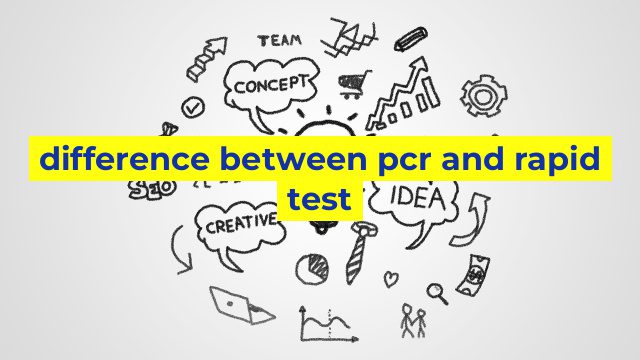Understanding the Difference Between PCR and Rapid Test
Introduction
The COVID-19 pandemic has brought about significant changes in the way we lead our lives, and testing has been one of the most crucial tools in the fight against the virus. As we navigate through this pandemic, it is essential to understand the difference between the various tests that are available for COVID-19. Two of the most commonly used COVID-19 tests are Polymerase Chain Reaction (PCR) and Rapid Test kits.
What is PCR test?
PCR is a laboratory-based test that detects the presence of the virus’s genetic material in a patient’s respiratory sample. The process involves amplifying the genetic material through a series of complex steps to detect the virus’s presence accurately.
What is a Rapid Test?
Rapid tests, as the name suggests, provide rapid results within minutes. These tests detect the virus’s antigen rather than its genetic material. Unlike PCR tests, these tests do not require any laboratory equipment or specialized training.
Accuracy
PCR tests are considered the gold standard in COVID-19 testing and are known for their high accuracy. These tests can detect the virus even in cases where the patients have low viral loads. Rapid tests, on the other hand, have a lower accuracy rate and a higher chance of a false negative result.
Speed of Results
PCR tests typically take about 24-48 hours to deliver results, given that the samples need to be sent to a lab. This delay in results can be problematic, especially when it comes to making prompt isolation and treatment decisions. In contrast, rapid tests offer quick results, often within 15-30 minutes, making it easier to detect and isolate infected patients much sooner.
Cost
PCR tests are typically more expensive than Rapid Tests due to the need for laboratory infrastructure, reagents, and technical staff. Rapid Tests, on the other hand, are relatively inexpensive and can be used in a range of non-clinical settings for disease control measures.
Usage
PCR tests are predominantly used in clinical settings such as hospitals and labs, where strict screening procedures are in place. Rapid Tests, however, are more commonly used in non-clinical settings such as airports, schools, and workplaces.
Conclusion
Both PCR and Rapid Tests have their advantages and disadvantages, and determining which test to use depends on the situation and the intended purpose of testing. Although PCR tests are more expensive, they offer higher accuracy and are best suited for clinical settings. Rapid Tests, on the other hand, are a more economical and convenient option and can provide results quickly. However, it is essential to keep in mind that these tests have accuracy limitations, and a negative result doesn’t guarantee that a person is not infected with the virus.
Table difference between pcr and rapid test
| Parameter | PCR Test | Rapid Test |
|---|---|---|
| Testing method | PCR (Polymerase Chain Reaction) involves making copies of the virus’s genetic material to detect the presence of the virus. | Rapid Antigen Test detects viral protein in a sample. |
| Accuracy | PCR tests have a high level of accuracy, with a low risk of false-negative or false-positive results. | Rapid tests have lower accuracy levels than PCR, with a relatively high-risk of false-negative results. |
| Timing | PCR takes longer to process and analyze, with results taking 24-72 hours to be generated. | Rapid tests generate results within 15-30 minutes, making them a faster option. |
| Cost | PCR tests are more expensive than rapid tests. | Rapid tests are cheaper than PCR tests. |
| Test availability | PCR testing is generally more widely available than rapid testing. | Rapid testing may not be readily available in all areas. |
| Use | PCR testing is used for diagnostic purposes to confirm active COVID-19 infection. | Rapid tests are used as a screening tool to detect COVID-19 infection, but may require further confirmation with PCR testing. |


